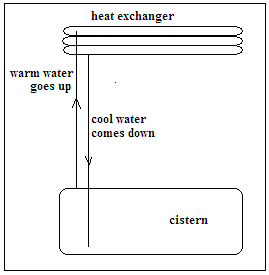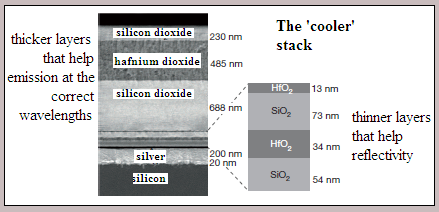A surface that can lose heat even while the sun shines may be an economical way to stay cool, says S.Ananthanarayanan.
Air conditioning is one of the greatest comforts of modern times, but also a villain that accounts for a large share of CO2 emissions. With rising global temperatures, air conditioning would become a greater necessity, both for comfort as well as to preserve food materials, but would also be a first candidate to curtail, to reduce electricity use.
But just as there are ideas of using the large reserve of geothermal heat buried within the earth, to save use of fossil fuel, there could be a way to bring about cooling by tapping the icy chill of outer space, and hence save the energy costs of refrigeration. Aaswath P. Raman, Marc Abou Anoma, Linxiao Zhu, Eden Rephaeli and Shanhui Fan, at Stanford University, report in the journal, Nature, what amounts to an optical umbrella that allows things to cool down by through what could be called a radiation drainpipe.
There have been earlier ideas of using the coolness of the night to chill things for the day. One way was a rooftop heat exchanger, which would cool and store water through the night, for use during the hot daytime. There has even been the real ‘radiative’ refrigerator, where the radiator surface lost heat at the 8 to 13 micrometer wavelength, which the atmosphere does not absorb – which means the heat was sent out to outer space – during the night. But such methods could not work in the daytime, as the radiating surface would be warmed, many times more than it cooled, by the sun. But the Stanford team reports success, for the first time, of an arrangement that cools down nearly 5°C, while standing in direct sunlight!

The principle is that all things cool by radiation, but things on the surface of the earth also gain heat, through sunlight and from the surroundings, which are warmed, both by the sun and by the heat that the surface radiates. But if the surface reflected most of the incident light, and the heat radiated by the surface were beamed out of the atmosphere, instead of warming the surroundings, it is possible that things could have net heat loss and cool down too! But, as the energy radiated by objects at normal temperatures is low, and readily absorbed, and the incident energy that comes from the sun is high, the conditions for net cooling are difficult to satisfy. The reflectivity, for one, needs to be over 94%. At the same time the radiation from the surface needs to be strong in the narrow window of wavelengths that can pass through the atmosphere. This combination has been difficult to implement – attempts with metallic foil reflectors to keep solar radiation off normal thermal emitters have not been successful in causing cooling while in the sunlight. And finally, the arrangement needs to be protected from the surroundings, anything in contact with the cooler device will warm up in the sun and make sure the cooler device does the same
The paper in Nature says that there has been a concept of how this could be done, with the help of 2-dimensional nanostructures to manipulate radiation and attain the required reflectivity and emissivity. But this proposed design involved a complex fabrication technique of very fine-scale components. The present design, which has also been realized in practice, uses a one dimensional film architecture, which can more easily be scaled up. The cooler itself is also installed in an apparatus that protects it from external heat and the actual temperature drop, while in sunshine, has been practically observed.
The reflector-emitter consists of seven alternating layers of the materials, hafnium dioxide and silicon dioxide, mounted on a 200 nm silver base, itself mounted on a silicon wafer. The thickness of the layers of the oxides, which have high and low refractive indices, respectively, were arrived by iterative optimization. The bottom four layers are thinner and they bring about the best reflectivity over the whole solar spectrum. The top three layers are thicker and are primarily responsible for the selective emissivity. Through a combination of material properties and optical effects, silicon dioxide emits strongly at the 9 µm wavelength and hafnium oxide does the same for 9-13 µm wavelengths. The seven layers together, then, make for very high reflection, which translates to very low absorption of solar radiation, and also for the highest emission of radiation in wavelengths that the atmosphere does not absorb. The effect is thus as if the cooler stack is both not warmed by sunlight, and also free to emit radiation, arising from its own temperature, clean out into space. The hafnium dioxide material can also be replaced by the cheaper titanium dioxide.

The housing of the cooler stack takes care of entry of heat from the surroundings. The silicon wafer, with the radiative cooling stack, is mounted on a polystyrene holder, which is supported by a clear acrylic box, fixed to a wooden frame. Just over the cooler stack is a thin polyethylene film, transparent to Infra Red radiation and acts as a wind shield. The cooler device is thus suspended in an air pocket and the whole arrangement is placed in the middle of a large rooftop, to make sure that the support of the cooler do not get warmed by external radiation. Experimental trials of the reflectivity and the emissivity of the device show 97% reflection through the solar spectrum, 300 nm to 4 µm, and strong, selective emission within the atmospheric window of 8-13 µm.

The device, which is called ‘passive cooling’, was demonstrated on a clear day in Stanford, shortly before 10 am, on a building roof. Immediately after the sample was exposed to sunlight, its temperature drops 4-5 C below the ambient. “This is a key signature of radiative cooling, and is counterintuitive: we typically think of surfaces increasing their temperature when removed from the shade and exposed to the sun during the day,” say the researchers in the paper. The sample in the trial was kept out in the sun for several hours and it steadily maintained a temperature 4-5°C below the ambient. Trials of watching the temperature of the sample as heat was externally supplied allowed measurement of the cooling of the sample, at about 40 Watts per square meter. This is substantial cooling, and the method is compares well with alternatives, like solar panels which power cooling systems. There is also scope to improve the design, to attain output of 100W per square meter
“Improving building efficiency with a view towards reducing the need for active cooling has taken on renewed urgency on our warming planet, where the increase in carbon emissions caused by air conditioning is predicted to be faster than the decline in emissions from reduced heating. In off-grid areas of the developing world, achieving radiative cooling during the daytime offers the opportunity to enable electricity-free cooling for critical needs like long-term food and medical supply storage. More broadly, our results point to the largely unexplored opportunity of using the cold darkness of the Universe as a fundamental renewable thermodynamic resource for improving energy efficiency here on Earth,” the authors say in the paper.
Do respond to : response@simplescience.in
------------------------------------------------------------------------------------------